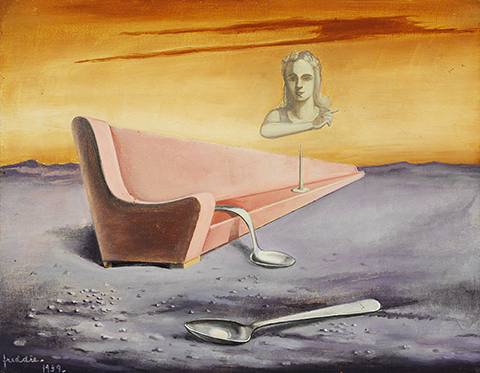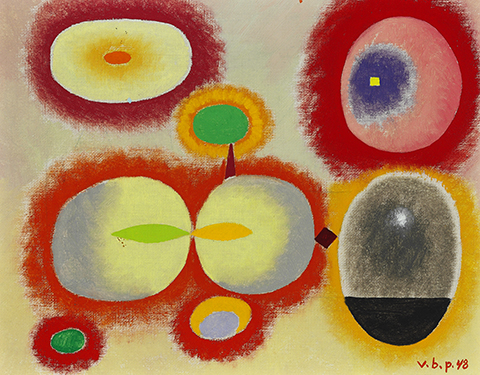The Staying Power of Surrealism

Rita Kernn-Larsen: "Nature morte", 1934. Signed. Oil on canvas. 74 x 98 cm. Sold for DKK 42,000.

Franciska Clausen: Composition, Paris 1928. Signed. Watercolour and gouache on paper. 14 x 23 cm. Sold for DKK 82,000.

Wilhelm Freddie: "Den Röda Soffan" (The Red Sofa). Sign. Freddie 1939. Oil on board. 19 x 24 cm. Sold for DKK 110,000.

Vilhelm Bjerke-Petersen: Composition. 1948. Signed. Oil on canvas. 22 x 27 cm. Sold for DKK 25,000.

Henry Heerup: Trophy. Junk sculpture. Painted wood. Sold for DKK 210,000.
We are looking for works by Scandinavian surrealists from the period around 1930-40, including names such as Rita Kernn-Larsen, Wilhelm Freddie, Erik Ortvad, Vilhelm Bjerke-Petersen, Elsa Thoresen, Harry Carlsson, Gustaf Munch-Petersen as well as prominent Danish artists at the time such as Franciska Clausen, Hans Øllgaard, Ejler Bille, Sonja Ferlov Mancoba and Richard Mortensen. The consignment deadline for the auction is Monday 19 August.
Spiritual Life and Human Desires
In 1924, the French author and poet André Breton writes the Surrealist Manifesto. This marks the beginning of one of the 20th century's main art movements which still reverberates in contemporary art. In the manifesto, Breton announces that the artist must explore his own subconscious and visualize it through artistic expression. In particular, it is the interest in the inner spiritual life and desires of man as well as the liberation of the subconscious, which is the driving force behind the experiments. In continuation of these thoughts, the surrealist artwork abounds with erotic and grotesque figures, indefinable landscapes and fragmented body parts, while organic shapes fill the canvases without restraint. In other words, reality flows together with the world of dreams.
A Liberation of the Human Mind
For the surrealists, art has revolutionary potential. It is the means to achieve a new awareness and liberation of man from the way of thinking that brought forth the endless horrors of World War I. The surrealist artists, therefore, reject both the established art scene and the bourgeoisie’s world view. Dreams and desires live in all people – high and low.
Surrealism in Denmark
As with so many of the other isms of the time, the point of origin is in Paris, but surrealism quickly becomes an international phenomenon. In Denmark, the new ideas are introduced with Wilhelm Freddie's work ”Frihed, lighed og broderskab” (Freedom, Equality and Brotherhood) from 1929-30 and later the artist group Linien’s first exhibition in 1934. Among the founders of this group were names such as Vilhelm Bjerke-Petersen, Sonja Ferlov Mancoba, Richard Mortensen, Ejler Bille, Hans Øllgaard and Henry Heerup.
Freddie is probably the purest surrealist in Denmark. His works revolve around controversial topics such as sexuality, eroticism, the body and pleasure, and they created quite the controversy at the time. With confiscations, scandals and prison sentences, he is seen as a true artistic enfant terrible. Below the surface, Freddie, as his foreign colleagues, is driven by an idealistic desire to liberate man's innermost being and needs through art.
While Freddie offends his Danish audience, artists such as Franciska Clausen and especially Rita Kernn-Larsen spend most of their adult lives abroad. When Kernn-Larsen enrols in Léger's Académie Moderne in Paris in 1929, she finds a place where she truly belongs, and at her first solo exhibition in Copenhagen in 1934, the press calls her "a female Picasso". Since then, she faded into obscurity quite undeservedly, but today she has become topical again through a series of exhibitions.
Surrealism has many aspects and can be seen in both Freddie's transformed body fragments, Bjerke-Petersen's landscapes, Henry Heerup's fragmented junk sculptures as well as in Øllgaard and Bille’s automatic drawings.
For further information, please contact:
Niels Raben: +45 8818 1181 · nr@bruun-rasmussen.dk
Niels Boe Hauggaard: +45 8818 1182 · nbh@bruun-rasmussen.dk
Kathrine Eriksen: +45 8818 1184 · ke@bruun-rasmussen.dk
Peter Beck: +45 8818 1186 · pb@bruun-rasmussen.dk